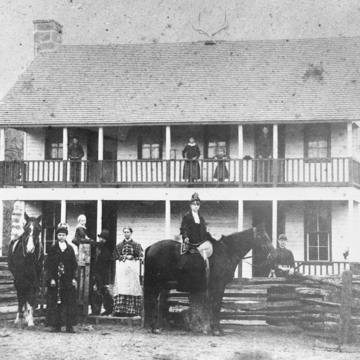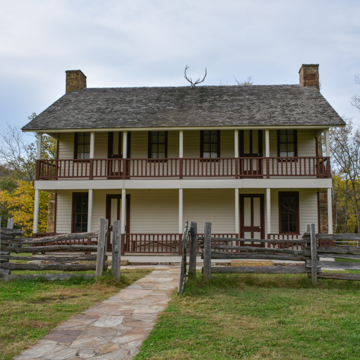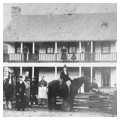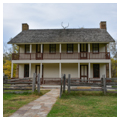Elkhorn Tavern, well built and spacious for the frontier age, is a saltbox house with the typical wide porch and an overhanging roof at the rear. The tavern was a stop on the route from St. Louis to Fort Smith. Built by politician William Ruddick (also known as Reddick) from Indiana and his son-in-law Samuel Burks, it was the largest building in the area and became a meeting place for the neighborhood. In 1858 Burks sold the house and 313 acres to Jesse and Polly Cox, who were from Kansas. The Coxes improved the tavern and farm surrounding it, covering the building with clapboards and erecting outbuildings. The name of the house derives from a large elk skull and horns that Jesse mounted on the ridgeline of the roof. After a telegraph line was laid through Benton County to Fort Smith and beyond, Jesse Cox became a telegrapher, and the tavern was a stop for the Overland Stage. In 1862, the fields around the tavern were used as a Union supply base and became the site of the Battle of Pea Ridge (also known as the Battle of Elkhorn Tavern), the most important Civil War battle fought in Arkansas. During the conflict the tavern was used as a Union army hospital and headquarters, but in 1863 Confederate guerrillas burned it; only two chimneys and the stone basement walls remained.
After the war, Joseph Cox, a son of Jesse and Polly, rebuilt the tavern, but time had altered the need for an inn at this location. Stagecoach lines became local, not transcontinental, and by the 1880s not only had railroads made stagecoaches redundant, but the tavern was too far removed from the railroad tracks for an inn. By the 1890s, the tavern’s business was visitors to the battlefield. In 1956, the site of the Pea Ridge battle was designated a national park, and in 1960 the tavern was transferred to the National Park Service, which restored it to its original form. It now has a full-width two-story porch, two entrance doors on each floor, exterior end chimneys of local limestone, and a modestly sized elk horn mounted on the roof. The tavern is open to the public as a museum.
A marker at the tavern describes the route of the Trail of Tears (the forced removal in the 1830s of Native Americans to Indian Territory in Oklahoma) that went through what is now this park and is now a component in the Trail of Tears National Historic Trail. On the park’s grounds is a monument honoring both sides in the Civil War, placed here in 1889 by Confederate and Union veterans. Titled A Reunited Soldiery and sculpted by a Miss Daniels, it is composed of a personification of Liberty standing on a marble shaft.


















